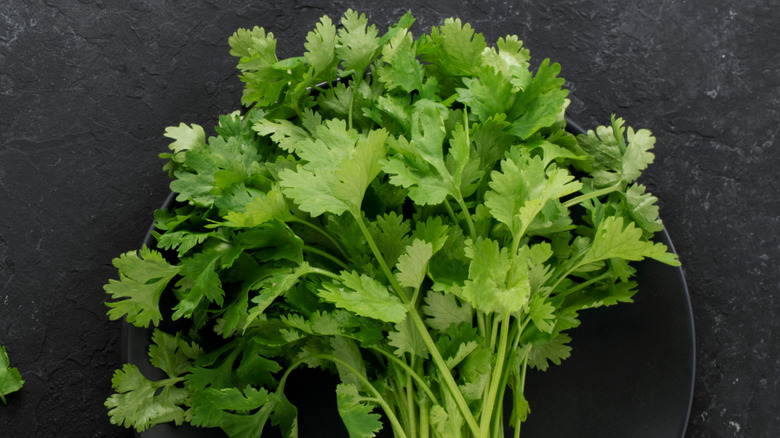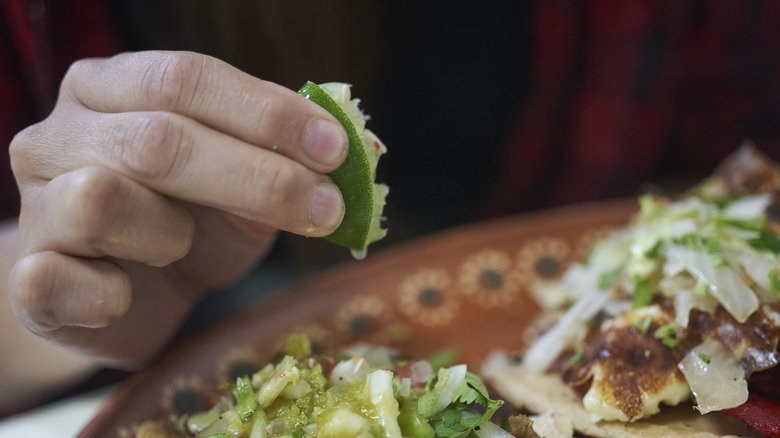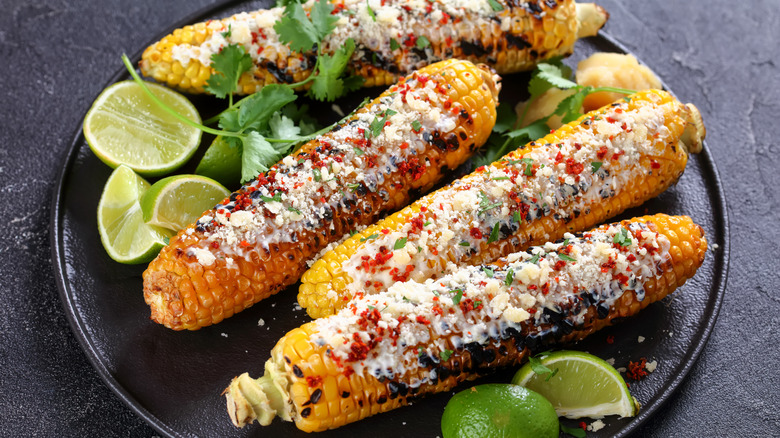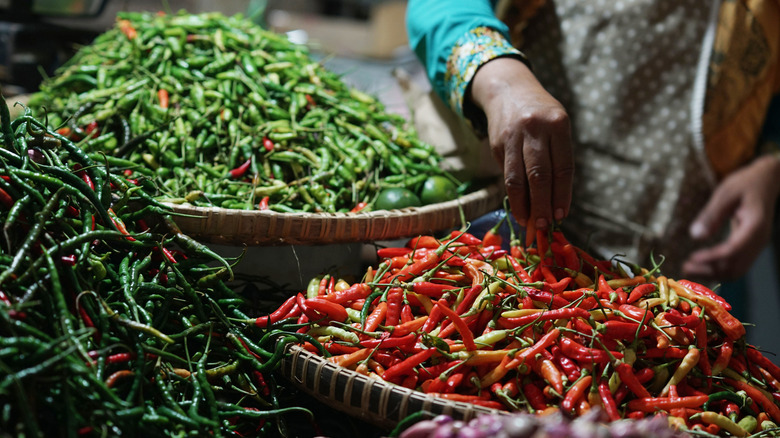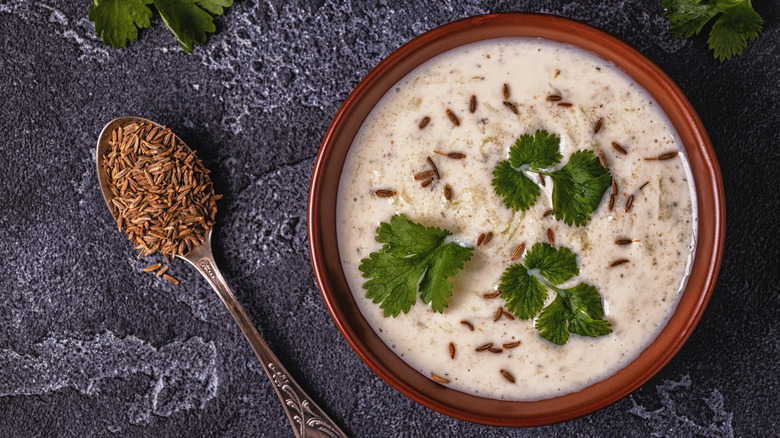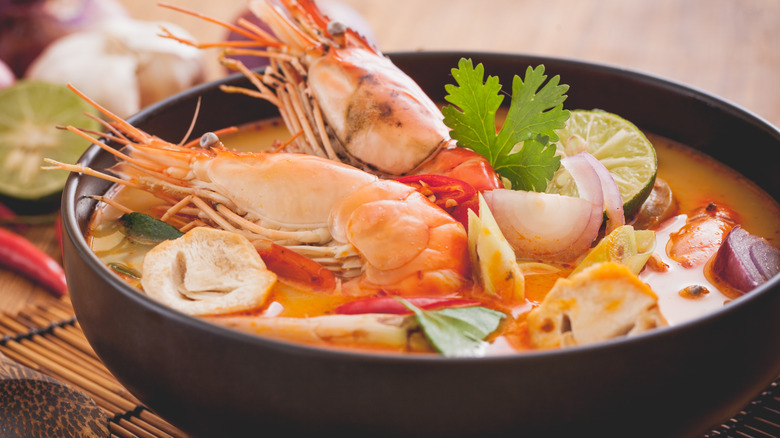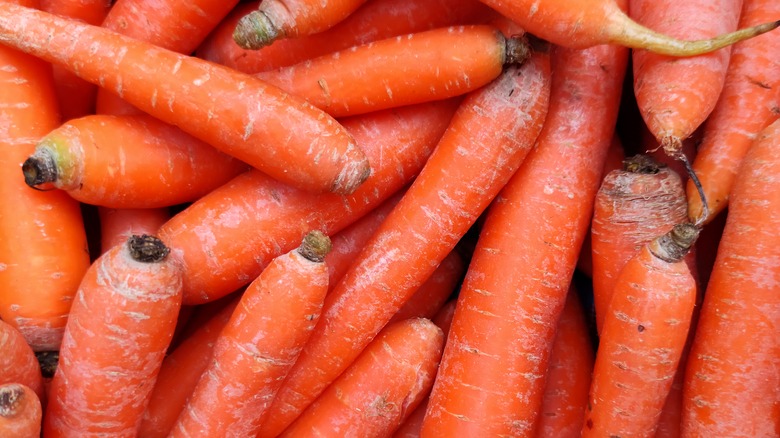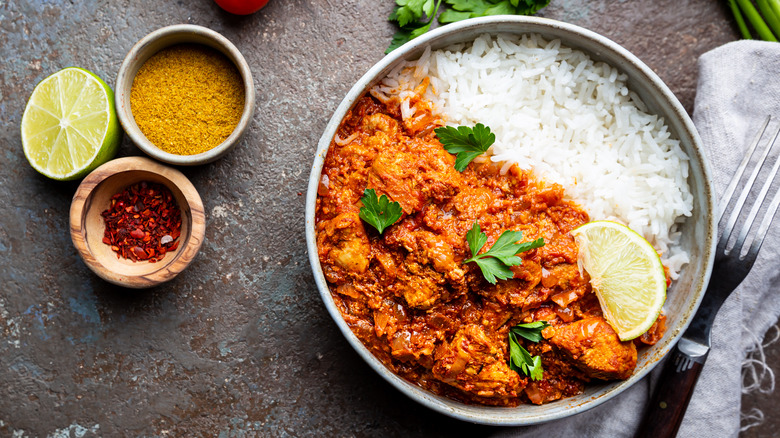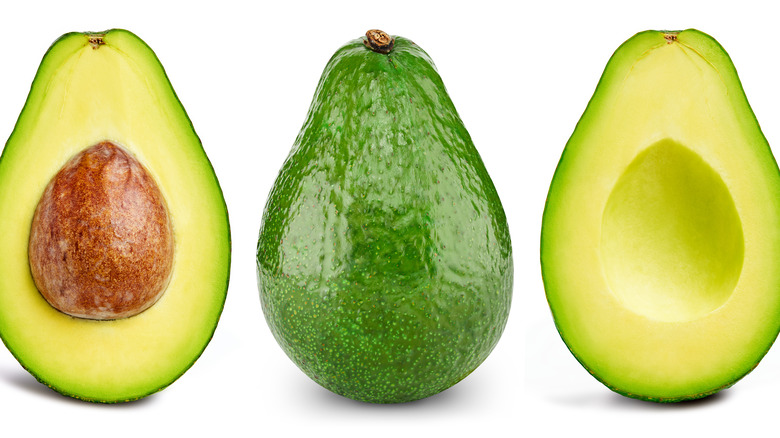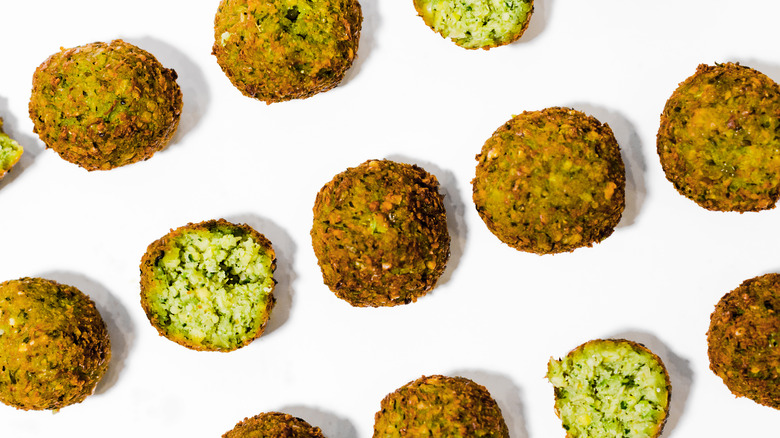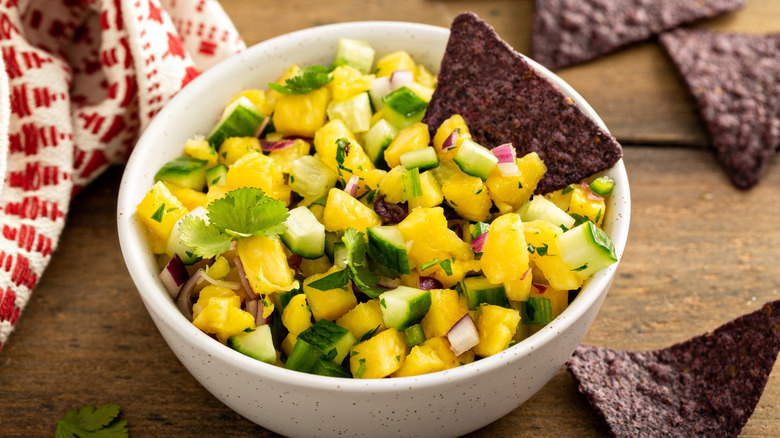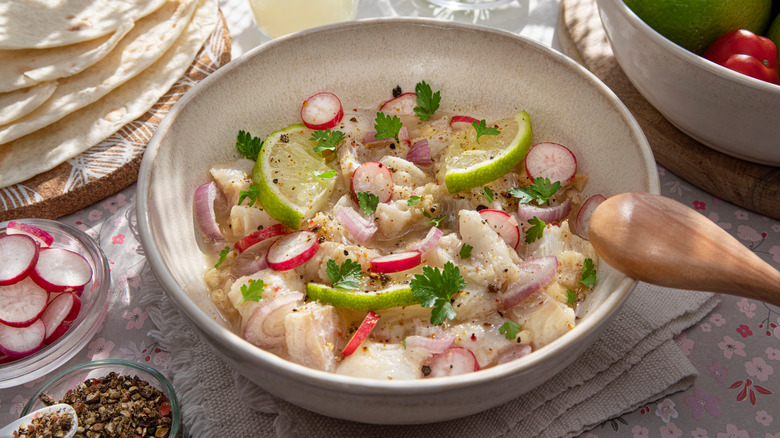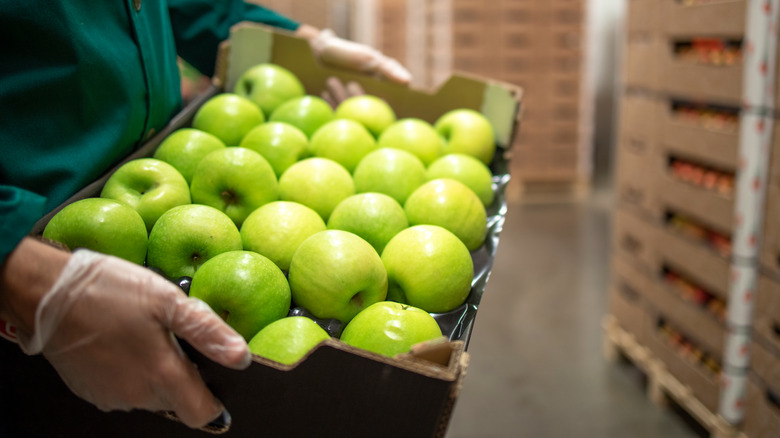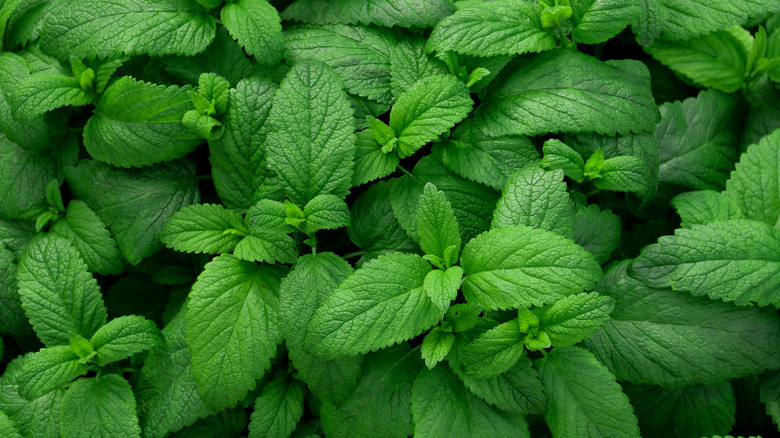The Best Ingredients That Go With Cilantro
Step aside Hawiian pizza, for today the title of most divisive food firmly falls to cilantro. This leafy, green herb, which is commonly referred to as coriander or Chinese parsley (via Britannica), is about as polarizing as foods come. This impasse is thought to be partly attributable to genetic differences in the human population. If you count yourself amongst these unlucky few who eat cilantro and taste soap, fear not — you are in the esteemed company of many prominent chefs, Julia Child included (per Britannica). However, you may want to brace yourself before reading the rest of this article.
As reported by The Guardian, cilantro's popularity in the United States is booming. This upward trend has come as a result of numerous reasons. Among these is the growth of Mexican and Asian cuisines, both of which utilize the herb heavily from breakfast to dinner (via The Independent). Celebrity chefs and their shows have also been a driver of cilantro's popularity, a fact that shouldn't be surprising, given cooking shows' long-standing ability to influence our own culinary practices (via The Guardian).
Yet another aspect of cilantro's rise to prominence is its versatility. Cilantro's slightly citrus flavor, balanced by an inherent pepperiness, ensures the herb can be used across courses and cuisines (per Gardening Etc). In this article, we look to celebrate that versatility by providing you with a range of ingredients — some well-established and some not — to pair with this fantastic herb.
Lime
Some duos work so well together that it seems they were tailor made for each other. Think Sherlock Holmes and Dr. Watson, Paul Hollywood and Mary Berry, or even mac and cheese. Disparate as all these combinations might seem, they all share the tell-tale mark of an iconic duo, and have become greater than the sum of their parts. In the food world, the ingredient which complements the taste and texture of cilantro to this degree is undoubtedly lime. Be it squeezed, zested, or sliced, the lip-puckering, tooth-clenching zing of lime balances beautifully with the cilantro's delicate flavor — a fact attested to by Bon Appétit, who labeled the two ingredients "soulmates."
Of course, cilantro and lime form the basic garnish for many Mexican dishes (per Texas Monthly). Yet, this fantastic flavor combination should not be limited to a few sprinkles here and a squeeze there. As demonstrated by Chipotle, the combination of cilantro and lime can carry a dish on its own. Their trademark cilantro-lime rice is so iconic it has inspired recipes in The New York Times (and driven Reddit users to despair as they try to recreate it), highlighting how infuriatingly good this potent flavor combination can be.
Corn
As previously mentioned, cilantro is a key ingredient in Mexican cuisine. It should therefore come as no surprise that the green herb compliments that other stalwart of Mexican cooking: corn. The importance of corn to Mexico cannot be understated. It is both an ingredient and emblem, a symbol and a staple (per Cultural Survival). The marriage of these two ingredients, one developed by Indigenous meso-American societies (via Britannica) and the other brought to the continent by Spanish colonizers (per Gourmet), reflects not only a culinary milestone, but also a record of Mexico's socio-cultural history.
Gastronomically, corn — which is often roasted to release its nutty flavor (per The New York Times) — is a natural vessel for the light, citrusy tang of cilantro. This pairing can be tasted in some of Mexico's most iconic dishes such as tacos and elotes. The former has become widely consumed in the United States, with 77% of Americans eating tacos (per Top). Yet, not everyone north of the border enjoys the cilantro-corn combination, and cilantro's propagation into Tex-Mex dishes has been met with some staunch resistance, as demonstrated by a disgruntled letter written by a reader of Texas Monthly.
Chili
The use of cilantro is not solely confined to Mexican cooking. Indeed, ancient evidence of cilantro consumption comes from Israeli caves (per NPR) and many other ancient civilisations (via Nutritional Geography). To this day, the herb features prominently in many of the World's cuisines. Across these communities, many have discovered that cilantro pairs exceedingly well with the heat and flavor imparted by chilis.
In the Middle East, this pairing often takes the form of zhoug, a fiery sauce that originated in Yemen (per the Los Angeles Times). Although the sauce may seem to be all about heat on first tasting, the inclusion of cilantro is of paramount importance. As chef and spice blender Lior Lev Sercarz explained, "Making zhoug without cilantro is like making hummus without chickpeas."
Of course, chili and cilantro both feature heavily in Asian cooking as well, with the combination appearing in dishes ranging from Indian curries (via Big Apple Curry) to Vietnamese sauces (per Bloomscape). Perhaps the most remarkable part of cilantro usage in Asia is the fact that all parts of the herb are widely used. Speaking to The BBC, chef Ranveer Brar explained, "Every part of it [the cilantro plant] is used in our cooking. The leaves are used for garnishing curries ... its stems and roots are used in soups and stews and its fruit or seeds are used as a popular spice."
Yogurt
Just as it is used to complement heat, cilantro can also be used in conjunction with cooling dishes, such as raita. The blend of cilantro and yogurt lends a delicate flavor to the dip, adding another dimension to your plate. The prominence of cilantro in raita and other aspects of Indian cooking has led to production of the crop booming within the country. As explained to the BBC by Dr. Bhopal Singh Tomar, a leading academic at the Indian Agricultural Research Institute "Forty years ago, it was a seasonal crop in India and was available only in the winters and was sold mostly in the cities. But today, coriander is grown throughout the year from imported seeds, and millions of Indians grow it in their own kitchen gardens."
Indeed, yogurt and cilantro prove such a popular combination that variations on the raita are now being found in the United States, topping bison burgers in St. Louis and alongside New York City's finest cauliflower steaks. The latter being cooked by James Beard winner John Doherty (per Broadway World) would suggest that this pairing may offer a new lease of gastronomic life for cilantro in the west.
Shrimp
So far, we have examined pairings where cilantro sits alongside other ingredients in the form of sauce or garnish. However, the citrusy herb can be used in direct conjunction with many ingredients that are the stars of your dish. First and foremost among these is shrimp. The slightly sweet flesh of this crustacean is well-suited to a pairing with cilantro, so much so that pre-packaged, cooked, and shelled prawns are often sold by high end supermarkets (such as Waitrose) blanketed in the herb's green leaves.
Shrimp prepared in this manner, and often finished on the grill, can be a real crowd-pleaser during the summer months. However, this combination is just as prominent throughout Asia, where shrimp and cilantro are often utilized in soups like Tom Yum Goong and noodle dishes such as Pad Thai. It is not a coincidence that both these recipes feature a number of the ingredients included in this article. Thai cuisine has long been known for its masterful utilization of cilantro, a fact that in decades past inspired Western chefs to try their hand at cooking with the herb (per The Guardian). The stellar reputation of Thai chefs when it comes to cooking with cilantro is built upon using the herb alongside a whole range of complimentary ingredients, forming part of what is a very complex cuisine (via Institute of Culinary Education).
Carrot
Despite its exceedingly leafy appearance and the marked absence of any orange, cilantro is actually part of a surprising taxonomic family. As explained by British restauranter Mark Sargeant to The Independent, cilantro is part of the Apiaceae family, more commonly known as the carrot family. It should come as little surprise, then, that carrot and cilantro form a classic combination. This pairing is often seen in the form of soup, a warming winter dish favored by chefs such as Michael Caines (via The Guardian).
Whilst this flavor combination is often associated with warming soups and hearty stews (per Tablet Magazine), there are many who have created fine dining dishes utilizing these two humble ingredients. Chief among these is Casa Velha, a Michelin-recommended Portuguese restaurant, which showcases red mullet alongside this tried and tested combination (per Portugal Resident). Some chefs, such as Lucía Freitas, are going even further. By combining carrot leaves — which are often known as fronds — with cilantro and other herbs, she surprises customers with a recognizable flavor combination, albeit in an unfamiliar manner (per the BBC).
Ginger
Don't let its gnarled and knobbly appearance put you off, because ginger is an absolute wonder when used correctly. Its fresh tang and spice is perhaps one of the most unique tastes in cooking (via Spiceography). Yet, this complex and strong flavor profile means that adding ginger to a dish can rapidly overpower other ingredients, as explained by Spiceography.
Fortunately, Vietnamese cuisine demonstrates how this difficult balancing act can be achieved. Recipes such as Ginger-Lime Shrimp Salad perfectly exemplify how ginger and cilantro can be used to amplify the delicate flavor of poached shrimp without overpowering it. However, the ginger-cilantro flavor combination need not be limited to food alone. The duo has risen to prominence in the cocktail world as well, as mixologists use the herb alongside ginger syrup to create so-called craft cocktails (per Star Tribune). That said, The Spruce Eats notes that adding cilantro to drinks can be a risky game, with many people finding its flavor unpleasant in cocktails.
Chicken
Perhaps the most infamous combination of cilantro and chicken comes from a dish of mysterious origin. Chicken tikka masala is a highly popular curry, and has been dubbed Britain's unofficial national dish (per Culture Trip). In this dish, the chicken is pre-cooked either by grilling or cooking in a tandoor (via BBC Good Food) before being added to a mild, creamy sauce which usually features dried cilantro. A fresh cilantro garnish is often added to finish.
The cilantro works so well in this dish, as well as in a variety of chicken recipes, because of the herb's inherent citrus flavor. This cuts through the rich creamy sauces chicken is frequently served in, and naturally compliments the gentle flavor of the meat (per Market House). When pairing cilantro with more flavorful meats like beef, the herb can often struggle to bring its full flavor to bear. In these instances, it is better to combine the herb with some other strong-tasting ingredients, creating powerful condiments such as this chimichurri from Cecilia Ryu.
Avocado
Avocado and cilantro probably stands as one of the most well-known flavor combinations of the 21st century, thanks to the meteoric rise of that outstanding Mexican dip, guacamole. Fuelled in equal parts by delicious flavor and a social media universe obsessed with the fruit, guacamole's climb to the top of the dipping world has been rapid. U.S. dollar sales grew by 5.3% from 2020 to 2021 (via Deli Business) and the average American now consumes 5.5 pounds of avocado per year (via Gro Intelligence).
As the addition of cilantro and a few other aromatics is one of the two keyways of influencing the flavor of your guacamole — the other being seasoning — it is important to ensure you are maximizing the herbs potential. Take J. Kenji López-Alt's advice and be sure to grind your cilantro in a pestle and mortar before adding it to the guacamole, as this ensures all the herbs flavors will be released into the dip (via Serious Eats).
Broad beans
It is fair to say that eminent chef and food writer Yotam Ottolenghi is a gastronomic icon, and has been a standard bearer for many ingredients over the past decades. During this time, Ottolenghi and his team have almost single-handedly brought ingredients such as tahini to popularity, along with an increased global respect for food from the Middle East in general (per Eater). Falafel, a dish that originated in Egypt (via The Guardian) has been one such beneficiary of the so-called Ottolenghi effect, rising to a position of prominence in Western countries. Falafel from Israel, where Ottolenghi was raised, is nearly always made with chickpeas. However, falafel from Arab countries traditionally uses broad beans (per Culture Trip).
Cilantro is used extremely frequently in both types of falafels. Indeed, the recipes from Ottolenghi, Sami Tamimi, Sharon Salloum, and Anisa Helou all call for the inclusion of the herb (via The Guardian). However, the heavy use of cilantro's aromatic notes alongside the flavor of rich, earthy broad beans, led The Guardian to declare Egypt as the world's best producer of falafel, consequently cementing the partnership of cilantro and broad bean.
Pineapple
Cilantro is not a herb that you'd necessarily associate with sweet flavor pairings, yet there is an emerging consensus that the herb can and should be used in desserts as well as mains, and starters. This idea has been spearheaded by Michelin star chefs like Daniel Clifford and his coriander and white chocolate dome. Dishes of this nature present a challenge, but that is what drew Clifford to a cilantro dessert in the first place, as he explained to Cambridgeshire Live. "People either love or hate coriander. My restaurant manager hates it. Hates it. But if I can get him to eat it and enjoy it, then I've achieved something. That's what we set out to do here."
Many of us can only dream of having the skill of a two-Michelin-starred chef. Fortunately, there is one flavor combination which makes introducing cilantro into sweeter dishes much less intimidating. That is the pairing of cilantro with pineapple, a combination made accessible to all cooks thanks to spicy pineapple salsas. Nearly identical ingredients and flavor profiles can be used to make easy desserts, as the sweet, tropical flavors of pineapple provide ample footing for the herb to gently assert its flavor without becoming overbearing. Most popular among these are cilantro and pineapple popsicles, with recipes for them abounding on social media throughout the summer months.
Raw fish
In much the same manner cilantro is suited to shrimp, the delicately sweet flavors of sashimi-grade raw fish match extremely well with the citrus-flavored herb. South America's utilization of raw fish most commonly takes the form of ceviche. Far removed from sushi, ceviche packs a powerful punch thanks to leche de tigre — a Peruvian marinade (per Saveur) — and lashings of cilantro. This fact is attested to by the herb's inclusion in the ceviches of both Jose Victoro Alarcon, a Peruvian chef who has firmly established himself in Baltimore (via Baltimore Magazine) and Eduardo Rodriguez, the chef of high-flying restaurant Zacatlán (per Albuquerque Journal).
The fact that traditional, well-respected versions of ceviche feature cilantro isn't unexpected. It is, after all, Peruvian cuisine's most used herb (via Lima Easy). Much like Mexican cuisine, cilantro use in Peru is often typified as occurring solely as a garnish. However, this is simply not the case. Cilantro plays an integral role in not only in ceviche, but also in Seco de Carne, a traditional Peruvian stew (via Eat Peru).
Green apples
Chutney is a vital part of Indian cuisine, used right across the various states and union territories. As explained by Tara Deshpande, an Indian actor and chef, "In many parts of India, chutney is a way to use up leftover ingredients, to enjoy seasonal ones, and, to use cheap ingredients to prepare something with lots of flavor" (via Indian Express).
Speaking to the same publication, Pushpesh Pant, an Indian food critic, highlighted the fact that many of these chutneys are prepared with fresh, raw ingredients. Perhaps the most famous of these is Indian green chutney, a cilantro and mint-based condiment that is served in Indian restaurants across the globe (per Greatist). As highlighted by Indian-born cookbook author Anupy Singla in her blog Indian as Apple Pie, green apples provide an exciting boost to this well-loved chutney. The fruit's tart edge adds an extra dimension to the condiment's fragrant and cilantro heavy flavor, proving that these unlikely bedfellows can — under the right circumstances — become a match made in heaven.
Mint
Keen to impress or improve, many cooks include a multitude of herbs in their dishes, supercharging the flavor in what becomes a balancing act of ever-increasing complexity. This high-stakes game, whilst not without risk, promises a huge return if executed correctly. This is attested to by the unlikely combination of two versatile yet flavorful herbs: cilantro and mint. A combination loved by internationally renowned chefs such as Yotam Ottolenghi (per The New York Times), cilantro and mint can be used to make flavor-elevating chutneys (via Jaime Oliver) or form part of moreish salads such as the crispy rice salad served at the North Hollywood Thai culinary institution Sri Siam Cafe.
This dish, noted as the precursor to Los Angeles restaurant Night + Market's wildly popular version (via The Infatuation), utilizes the full range of both herbs, resulting in a dish which crackles with energy. This is partially thanks to a Thai culinary practice where cilantro roots are used to impart a taste that differs slightly from the leaves and upper part of the stem (per Serious Eats).
